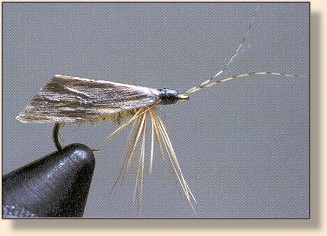Cinnamon Sedge (Caddis) (Hydropsyche/Ceratopsyche)
By Carl Richards and Bob Braendle
...The main problem imitating an adult caddis lies with the
wings which are translucent and have a sheen. Hair and
feathers alone do not possess this sheen. We will present
some materials which overcome these difficulties.
Materials List:
Hook size: Tiemco 100, sizes 16 - 18.
Body: Cinnamon spun fur or synthetic dubbing.
Wing: Game bird body feathers on Scotch tape.
Legs: Brown hackle.
Head: Black thread.
Antennae: Brown mallard side feathers.
Tying Instructions:

1. Preparation of the wings.
a. Place a body feather of a Bob White, dark partridge,
or ruff grouse on a piece of frosted Scotch tape.
b. Brush Seal-All cement over the feather (the glue on
the Scotch tape is not waterproof).

2. When the glue is dry, fold the taped feather in half at
the stem.

3. Clip to shape.

4. Dub a fat body.

5. Tie in the antennae.

6. Tie in and wrap the hackle and clip the top. You can clip the bottom
on the stream if necessary.

7. Tie in the prepared wing and super glue the wing at the point of
attachment. This keeps the wing from twisting when casting it. Tie in
the head and whip finish.
Notes on this Fly:
When viewed from the bottom the wing needs to form an angle of 15
degrees from the outside edges. This is narrower than many
patterns prescribe. If you choose to use deer hair as a wing
material, you must select hair that flairs only slightly. You
can narrow the angle of the wing by wrapping back up the wing three
or four times with less pressure than the previous to compress it.
Then wrap forward with increasing pressure to where you started.
When using deer hair try placing a small amount of light dun Z-lon
to add a little sheen which is present on the natural.
If you choose to use the two feather wing technique you should
treat the feathers with a tough adhesive. Goop or Aqua Seal
thinned with acetone or Goof Off are the best adhesives we are
aware of. Apply the cement by putting a drop on the lower part of
the feather and drawing it between your fingers.
A new material that looks promising is Shimzaki Air-Thru. The
best way to shape this material is to fold it twice placing it
in wing burners with the bottom of the burner one sixteenth of an
inch to the fold. Burn only the top of the wing with the Hot-Tip
cauterizing tool. Then cut the bottom and back of the wing, and
by trimming the rest we can open them up so they tie-in tent-like
over the body. This material takes markers and acrylic paint so
spots and patterns can be place easily.
No matter what material is used for wings be aware that different
families of caddisflies have differently shaped wings. . .
~ Carl Richards and Bob Braendle
Credits: Excerpt from Caddis Super Hatches, by
Carl Richards and Bob Braendle, published by Frank Amato Publications.
|



